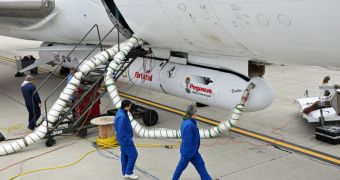The Orbital Science Corporation (OSC) L-1011 Stargazer aircraft has just been outfitted with the Pegasus XL rocket that will deliver the NASA Nuclear Spectroscopic Telescope Array (NuSTAR) spacecraft to Earth's orbit.
The aircraft is located at the Vandenberg Air Force Base (VAFB), in California, where it is currently being prepared for its departure to Kwajalein Atoll, in the central Pacific. This is where the mission will launch from on June 13, at 8:30 am PDT (1530 GMT).
The spacecraft itself is packed inside the payload fairing of the Pegasus XL rocket, which is also designed and built by OSC. The delivery system is attached to the underbelly of the carrier aircraft. This is how it will be transported to the Pacific, and then high in the atmosphere, during launch.
Once a sufficiently high altitude is reached, the Pegasus XL will separate from the Stargazer, and ignite its own thrusters, propelling its cargo to orbit. The aircraft will begin its journey to Kwajalein Atoll later today, and will arrive tomorrow, June 6.
“We will see the hottest, densest and most energetic objects with a fundamentally new, high-energy X-ray telescope that can obtain much deeper and crisper images than before,” Fiona Harrison explained.
She is the one who first conceived the X-ray telescope, about two decades ago. The researcher is currently the mission's principal investigator, and is based at the California Institute of Technology (Caltech), in Pasadena.
“NuSTAR uses several innovations for its unprecedented imaging capability and was made possible by many partners. We're all really excited to see the fruition of our work begin its mission in space,” added NuSTAR mission manager Yunjin Kim, from the NASA Jet Propulsion Laboratory (JPL), in Pasadena.
The satellite will orbit the planet at an altitude of around 550 kilometers (about 342 miles). Some of its preferred targets will be supermassive and stellar-size black holes, merging neutron stars, exploding stars, and other similar events. The solar atmosphere will also be investigated in detail.
This is the first space-based X-ray observatory that can be focused on specific targets. Experts expect to get images at least 10 times clearer than possible with current spacecraft. This will enable astronomers to study and determine the speed at which black holes spin, something that is not known today.
NuSTAR is around 100 times more sensitive to the wavelengths it's designed to see than any other telescope of its kind. Using data from this mission, scientists will be able to refine their understanding of high-energy, X-ray sources in the Universe.

 14 DAY TRIAL //
14 DAY TRIAL //